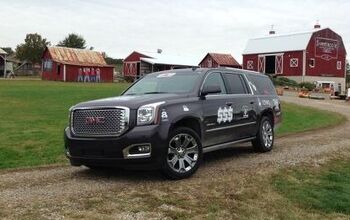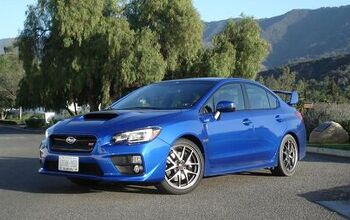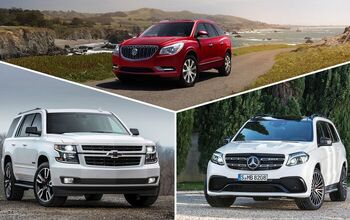2015 GMC Yukon XL Review
Where do you go if you need a vehicle that can haul as many people as a minivan, carry as much cargo as an SUV, and tow as much as a pickup truck?
FAST FACTS
| Engine: 5.3L V8 Makes 355 hp, 383 lb-ft of torque, 6.2L makes 420 hp and 460 lb-ft of torque. |
| Transmission: Six-speed automatic. |
| Fuel Economy: 15 mpg city and 21 mpg highway (2WD) or 14 mpg city and 20 mpg highway (4WD) |
| Price: $50,030 to start or around $82,000 for a well-equipped Denali model. |
Most people would go straight to their local Chevy dealer for a Suburban — but the ‘Burb has a fraternal twin, a slightly more upscale version called the GMC Yukon XL. So why would you buy a GMC instead of a Chevrolet?
This is a question buyers have been pondering for decades. General Motors introduced a GMC-branded Suburban way back in 1937, just a couple of years after it made its debut under the Chevy sign. GMC’s Suburban was even called the Suburban until 1999, when it was renamed Yukon XL, the two-letter suffix distinguishing it from the short-wheelbase Yukon, itself a near-twin to Chevy’s Tahoe.
Differences in Both Style and Substance
So what’s the difference between a Yukon XL and a Suburban? Not much, at least until you get to GMC’s high-end Denali model. Both the Yukon XL and the Suburban are all-new for 2015 and both are based on GM’s new-for-2014 half-ton pickups. The GMC gets its own front-end styling, with vertically-oriented taillights that sweep back into the fender, Cadillac-style. As with other GMC models, the SLE and SLT models get a three-bar grille, while the top-of-the-line Denali gets a massive chrome billet-style grille.
Inside, the Yukon does its best to live up to GMC’s “Professional Grade” logo. The metal trim is real metal and the wood trim is real wood, as opposed to painted and/or patterned plastic in the Suburban. Other than that, and the addition of a head-up display for the Denali (which projects speed, directions, and other info into the windshield, just below the driver’s line of sight), the Yukon’s interior is nearly identical to the Chevy’s, and we’re not surprised: Any significant changes and it might start to elbow in on the territory of the pricier Cadillac Escalade ESV, another Suburban relation.
There is one major difference between the two super-utes: the 6.2-liter V8. A close relative of the Corvette motor, this engine puts out 420 horsepower and 460 lb-ft of torque, provided you feed it a diet of premium fuel. (It’ll run on regular with a slight decrease in power). But it only comes on the top-of-the-line Denali — the lesser SLT and SLE models share their 355 hp 5.3 liter V8 with the Suburban. Both engines employ direct fuel injection, variable valve timing and a cylinder deactivation feature that runs the engine on four cylinders when power demands are low, but only the 5.3 is E85 capable, and fueling it on this ethanol blend bumps up its power output to 380 hp.
Pros and Cons of the Bigger Engine
You might be expecting the Yukon XL Denali to be able to tow and carry more owing to its larger, more powerful engine, but you’d be wrong. The 6.2 liter Denali’s payload rating is actually about 125 lbs lower than the 5.3 liter Yukon XL, while towing capacity drops by 200 lbs, both owing to the Denali’s heavier weight. (Remember, towing and hauling capacities are functions not only of engine power, but of suspension and brakes as well).
There’s definitely a difference in thrust, though. The 5.3 liter does a perfectly acceptable job moving the Yukon XL’s three-ton curb weight, but the 6.2 adds a bit more muscle (and a bit more noise). EPA fuel economy estimates are slightly lower with the bigger engine: 15 MPG city/21 MPG highway for the rear-drive 6.2 and 14/20 with four-wheel-drive, as opposed to 16/23 and 15/22 respectively with the 5.3 liter V8. The Denali also gets GM’s magnetic ride control (MRC) shocks, which allow instant changes to the damping rate and help the Yukon XL stay fairly flat in corners. With or without MRC, the Yukon XL rides comfortably and very quietly; Denalis get extra help courtesy of an active noise-cancelling system. As for the handling, “agile” isn’t exactly the first word that springs to mind, but the Yukon XL is tidier than we expected given its weight. Its extra bulk and length compared to the short-wheelbase Yukon give it a more settled feel.
Doing Daily Duty
When it comes to pure functionality, the Yukon XL and the Suburban are identical. Both offer seating for up to nine, though that requires the optional three-place split-bench front seat, which is offered only in the cloth-upholstered SLE base model. We expect most buyers will go for buckets in front, which are separated by a wide armrest that covers a large storage cubby. Customers can again choose a three-place bench or twin buckets for the second row. The third row seat isn’t as roomy as we would have liked — for reasons that we can’t quite fathom, the second-row seats don’t slide fore and aft — but at least it doesn’t sit flat on the floor, although it does fold flat into the floor when not needed, and it does so electrically via switches conveniently located near the tailgate.
Which leads us to what the Suburb– sorry, the Yukon XL does best: carrying people and stuff. With all three rows of seats in place, the Yukon can still haul 39.3 cubic feet of luggage, more than most two-row SUVs. Stowing the third-row seat increases cargo space to 76.7 cubic feet. Flip and fold the second-row seat, and now you’re staring into a gaping maw of 121.1 cubic feet, enough to get your phone number permanently affixed to the fridge of every acquaintance who might someday need to move a sofa.
Carrying capacities are also similar between the Yukon XL and the ‘Burb, with around 1,650 lbs of payload capacity (4x4s and Denalis carry slightly less) and between 7,800 and 8,300 lbs of towing capacity with the heavy-duty trailering package, which includes an integrated electric trailer brake controller. The short-wheelbase Yukon is rated to tow more, but with an extra fourteen inches between front and rear wheels, the XL provides extra stability for longer trailers.
Wide Range of Prices
Surprisingly, there isn’t a huge difference in pricing and trim levels between the GMC and Chevrolet versions. The Yukon XL SLE is priced at $50,030 including destination charge ($3,000 more with four-wheel-drive), about $1,700 more than the Suburban LS. The SLE has a cloth interior, just like the base-model Chevy, but comes standard with nice-to-haves like a Bose stereo and automatic rain-sensing wipers, which aren’t offered on the base-model ‘Burb.
The SLT model jumps up to $58,430, but adds a long list of equipment including leather upholstery, heated and cooled front seats, a power tailgate, keyless entry and ignition, and power adjustment for the steering column and pedals. A Yukon XL SLT with all the options tops out just under $69,000, about six grand short of a full-boat Suburban LTZ, but the Denali takes it up to a higher level: $66,375 for starters and around $82K with all the option boxes checked.
General Motors insists that GMC buyers don’t visit Chevrolet dealerships and vice-versa, but if we were shopping for one of these behemoths, we sure would. Not that genuine metal trim versus painted plastic would be enough to swing a purchase decision; rather, we look at the slight difference in options as an opportunity to get the exact vehicle we want.
That said, it’s too bad that GMC has chosen to tie engine availability to trim level. If we were going to tow with our Yukon XL, we’d want the bigger engine for the extra confidence and peace of mind, and if trailering wasn’t in our plans, we’d want the smaller engine for its better fuel efficiency. The fact that the most-powerful engine is restricted to the Yukon XL with the lowest towing capacity seems more like a bureaucratic blunder than a sensible product-planning choice.
Still, we like the GMC Yukon XL for all the same reasons we like the Chevrolet Suburban: it’s big, brawny and capable. We’ll remind our readers that if you don’t need quite so much capacity, there are more cost-effective choices out there: GMC’s own Acadia is a roomy seven-to-eight-seater with a lower price and better fuel economy, but without the Yukon XL’s towing and hauling capabilities. And the short-wheelbase Yukon trades cargo space and long-trailer stability for quicker acceleration, easier parking, and marginally better gas mileage.
The Verdict
The fact that the Yukon XL is stuck between the Chevrolet Suburban and the Cadillac Escalade ESV limits its prospects a bit, and as this is a good towing vehicle, we’re disappointed that GMC has limited the biggest engine to the most expensive trim level. But we like what it does: The Yukon XL is big and capable, and it drives like an SUV rather than a truck. We may not see the sense in the marketing plan, but we like the Yukon XL.
LOVE IT
- Roomy, strong and capable
- Quiet, comfortable ride
- Drives better than expected considering its size and weight
LEAVE IT
- Big and unwieldy compared to most seven-seat SUVs
- Big engine only available with top-trim level… and lowest towing capacity
More by Aaron Gold































Comments
Join the conversation
The 2015 Yukon has significant issues with safety and performance which make the vehicle dangerous to drive. GM knows about these issues yet they continue to force customers to drive under these unsafe conditions. After a year of trying to work with GM to resolve these issues, I have found that they just don't care and would rather force customers to the point of filing a claim under the lemon law. As a (former) loyal GM customer, I expected that they would stand behind their product but they just don't. I absolutely would think twice about purchasing ANY GM vehicle.